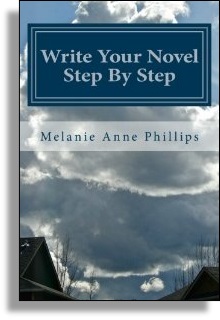
By Melanie Anne Phillips
Creator of StoryWeaver
Read it Below for Free…
~ Step 5 ~
Pulling It All Together
In Step 2, you jotted down any and all story ideas you may have already had for your novel. In Step 4, you probably generated a huge number of additional creative ideas for your novel. (If not, repeat Step 4 until you do!)
Problem is, the resulting collection of notions for your story from Steps 2 and 4 probably ranges far and wide, resulting in a hodgepodge of interesting concepts and schemes, all out of order and jumbled up in something of a chaotic mess.
So, before we go on into future steps, we need to do a little necessary housekeeping lest things get out of hand. Just as we boiled down your Step 2 ideas into a single log line, in this step we’ll pull together all the material you’ve created so far into a more manageable form: a synopsis of your novel,
A synopsis is like a map of the ground your story is going to cover, noting all the landmarks and important things that happen at them. Just as we originally had you jot down any ideas you already had in Step 2 and then boil them down to a single log line in step 3, we’re now going to take all the creative concepts you spewed out in Step 4 and pull them together into a this single conversational description of your novel’s content.
The length of a synopsis is completely variable. The shortest form would be a thumb-nail sketch, perhaps just a paragraph long – the minimum necessary to outline the key elements and scope of your story. Typically, the longest synopsis is usually no more than a page or two, though can be far more extensive than that.
So, don’t feel compelled to write more than comfortably flows or to limit yourself to less than you have. Tolkien, for example, created whole worlds, histories, cultures, and languages in synopsis form before putting any of it in story form.
Our goal here is simply to take that unwieldy shopping list of story elements from Steps 2 and 4 and to turn it into conversational language that, more or less, describes all the interesting people, events, topics, and stylistic flourishes you’d like to include in your novel, as if you were talking about your story to a friend, rather than actually trying to tell your story.
So, for this step, your task is to refer to all that you created so far and describe it as if you were telling someone about your story who was very interested in it and wanted to hear every juicy detail.
“My novel is about….” There. I started it for you. Now, go to town. Guided by your log line that describes the crux and center of your novel’s concept, write your synopsis of every interesting and/or essential thing that is going to be in it, based on the work you’ve done in the last step.
Sample Synopsis (from my own work):
Snow Sharks: Don’t Eat Red Snow
The government has been developing a new breed of shark that lives in snow rather than water for use as mobile land mines in places such as Siberia or the Arctic. A transport plane carrying them crashes in a storm high in the Rocky Mountains, just above a high-
Normally closed at this time, the resort was opened for a powerful client so that his college-
Characters include the handsome but stupid jock, the stuck-
Scenes include night skiing where the proprietors had installed disco lights on the ski run, so they light up and create changing colored patterns under the snow. During the night skiing, we see one of the kids ski by, followed by a silhouette against the disco lights of a snow shark following him. This is the first attack that alerts them that something deadly is out there on the slopes.
In a later scene, the jock trying to escape by out-
The government sees this as a great opportunity to see how effective the sharks are and send in an agent to document but not interfere. He ends up dying a horrible death that both divulges to the kids what the government has done and provides the idea of how to escape.
Ultimately, they learn the sharks can no longer live in water, only in snow, so they blow up a geothermal spring to flash-
Armed with this rather cliché example, it’s time to write the first synopsis for your own novel. As we continue through our step by step method, we’ll pause after each major new creative effort to fold what you’ve just developed into a revised synopsis. In this way, you have a story right from the beginning that is continually evolving, step by step, into your finished novel.
Next, in Step 6, we’ll stand back a bit to see the first draft of your synopsis just as your readers will, looking for any holes they might see. Then in the step after that, we’ll begin to fill them.
Note…
All these steps are drawn from StoryWeaver which automates the process by quoting and referencing your responses to earlier steps and providing many additional tips, tricks, and techniques. To try it risk-free for 90 days, and for complete features and details click on the image below.

